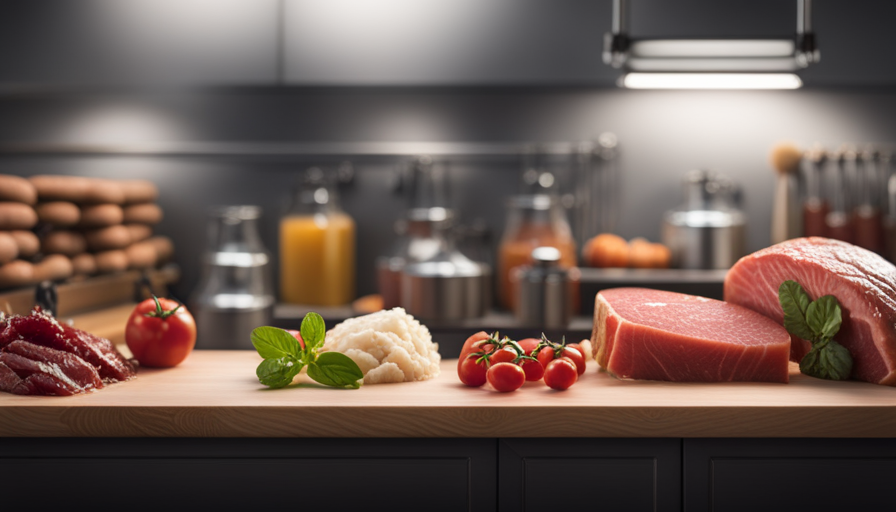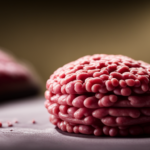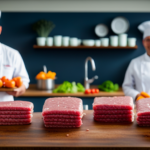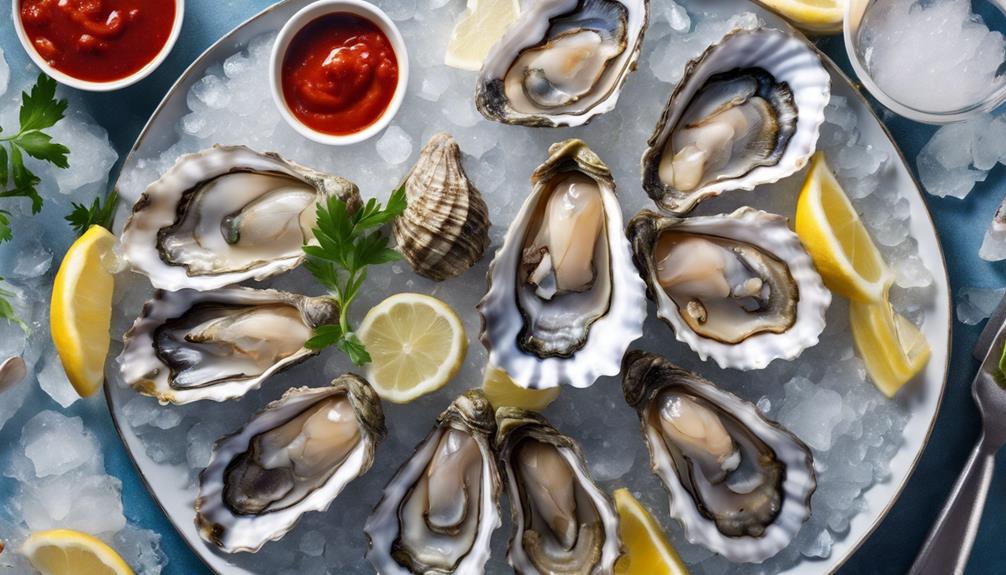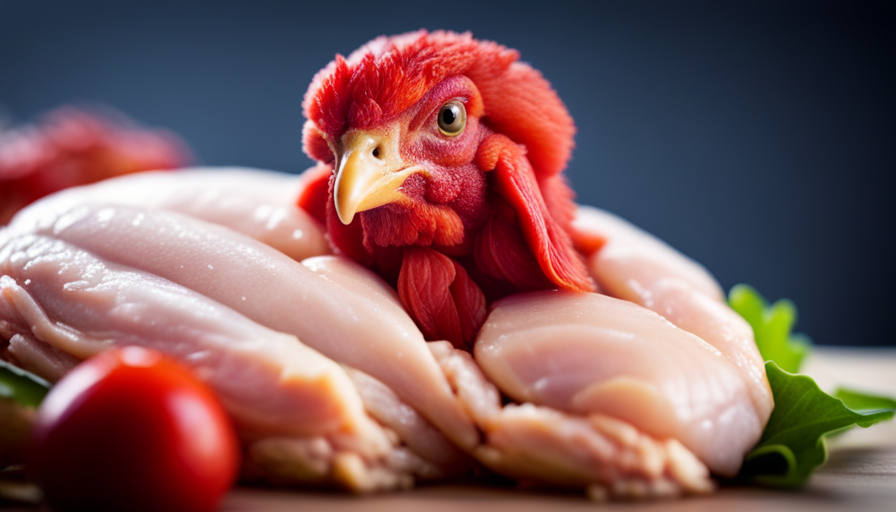I will always remember the moment when I made a beginner’s error in the kitchen. After a tiring day at work, I chose to cook a tasty meal using ground beef. But in my fatigue, I neglected to place it in the refrigerator before going to sleep.
The next morning, I was tempted to cook it up and enjoy a hearty breakfast. But then, I remembered the golden rule of food safety: never eat raw ground beef that has been sitting on the counter all night.
You see, raw ground beef is a breeding ground for harmful bacteria like E. coli and Salmonella. These pathogens can multiply rapidly at room temperature and cause serious foodborne illnesses. In fact, according to the Centers for Disease Control and Prevention, foodborne illnesses affect millions of Americans every year.
To avoid falling victim to these illnesses, it is crucial to understand the importance of proper temperature control and refrigeration. Additionally, practicing good food handling techniques and cooking ground beef to a safe temperature are essential for ensuring food safety.
In this article, we will explore the risks of bacterial contamination, the dangers of foodborne illnesses, and provide tips for safe food storage and handling. So, let’s dive in and learn how to protect ourselves from the potential hazards lurking in our kitchens.
Key Takeaways
- Leaving raw ground beef out overnight can lead to bacterial contamination and increase the risk of foodborne illnesses.
- Proper temperature control and refrigeration are crucial for food safety to slow down bacterial growth and preserve food quality.
- Cross-contamination can occur if raw meat is not handled properly, so it’s important to use separate cutting boards and utensils for raw and cooked foods and to practice proper handwashing.
- Cooking ground beef to a temperature of 160°F (71°C) is necessary to kill harmful bacteria and ensure food safety.
The Risk of Bacterial Contamination
You might be tempted to dig into that juicy raw ground beef that’s been sitting on the counter all night, but let me tell you, the risk of bacterial contamination is not something you want to mess with. Consuming raw ground beef that has been left out for an extended period of time can expose you to harmful bacteria like Salmonella, E. coli, and Campylobacter.
These risk factors are why it’s crucial to handle and store meat properly. One of the main risk factors for bacterial contamination is temperature abuse. When meat is left at room temperature, bacteria can multiply rapidly, especially in the danger zone between 40°F and 140°F (4°C and 60°C). This is why refrigeration is key to prevent bacterial growth.
Additionally, cross-contamination can occur if raw meat comes into contact with other foods or surfaces, spreading harmful pathogens. To prevent bacterial contamination, it is essential to follow proper food safety practices. Store raw ground beef in the refrigerator or freezer, and make sure to thaw it in the refrigerator, microwave, or cold water. Avoid leaving it out at room temperature for more than two hours.
When handling raw meat, wash your hands thoroughly with soap and water before and after, and use separate cutting boards and utensils for raw and cooked foods. Understanding the risk factors and prevention measures associated with bacterial contamination is crucial for ensuring food safety.
Now, let’s delve into the growth of harmful pathogens and why it’s important to cook ground beef thoroughly.
The Growth of Harmful Pathogens
If left out all night, harmful pathogens can grow on raw ground beef like weeds in a neglected garden. Bacterial growth is influenced by various factors, known as growth factors, such as temperature, moisture, pH level, and time. These factors create the perfect environment for bacteria to multiply rapidly and pose a risk to our health.
Temperature plays a crucial role in the growth of harmful pathogens. When raw ground beef is left at room temperature, which is typically around 70°F (21°C), bacteria can thrive and multiply. Moisture also provides an ideal breeding ground for bacteria, allowing them to reproduce and spread. The moisture content in raw ground beef, combined with the warmth of the room, creates an ideal environment for bacterial growth.
Time is another important factor. The longer raw ground beef is left out, the more time bacteria have to multiply and reach dangerous levels. Harmful pathogens can double in number every 20 minutes under favorable conditions, leading to a rapid increase in contamination.
Understanding the growth factors that contribute to bacterial growth on raw ground beef emphasizes the importance of proper food handling and storage. It is crucial to refrigerate raw ground beef promptly and avoid leaving it out at room temperature for extended periods. By doing so, we can minimize the risk of foodborne illnesses caused by bacterial contamination.
Without proper precautions, these harmful pathogens can lead to serious foodborne illnesses. Therefore, it’s essential to handle and store raw ground beef safely to protect ourselves from potential health risks.
The Danger of Foodborne Illnesses
Foodborne illnesses can be incredibly dangerous and pose a risk to our health. It’s crucial to understand the importance of foodborne illness prevention and safe food handling practices to protect ourselves and our loved ones. Here are three key points to keep in mind:
-
Wash your hands thoroughly: Proper handwashing is essential in preventing the spread of harmful pathogens. Use warm water and soap for at least 20 seconds before and after handling food.
-
Keep raw and cooked foods separate: Cross-contamination can occur when raw and cooked foods come into contact with each other. Use separate cutting boards and utensils for raw and cooked foods to avoid this risk.
-
Cook food to the correct temperature: Cooking food thoroughly kills harmful bacteria. Use a food thermometer to ensure that meat, poultry, and seafood reach the appropriate internal temperature.
By following these safe food handling practices, you can greatly reduce the risk of foodborne illnesses. However, it isn’t enough to rely solely on safe food handling practices. Proper temperature control is also crucial in preventing the growth of harmful pathogens.
The Importance of Proper Temperature Control
Proper temperature control is crucial for ensuring the safety and quality of our meals. Temperature abuse can have a significant impact on food quality and can also lead to the development of harmful bacteria, resulting in foodborne illnesses. The role of proper temperature control in preventing these illnesses cannot be overstated.
When food is not stored or cooked at the correct temperatures, bacteria can multiply rapidly, increasing the risk of contamination. This is especially true for perishable foods like ground beef, which can harbor harmful bacteria such as E. coli. Allowing raw ground beef to sit on the counter all night provides an ideal breeding ground for bacteria, putting anyone who consumes it at risk.
By storing and cooking food at the right temperatures, we can effectively prevent the growth of bacteria and reduce the risk of foodborne illnesses. Refrigeration, for example, plays a crucial role in preventing spoilage by keeping food at a low temperature that inhibits bacterial growth. It is important to remember that temperature control is not just limited to storage, but also applies to cooking food thoroughly to kill any existing bacteria.
Proper temperature control is essential for maintaining the safety and quality of our meals. By understanding the impact of temperature abuse on food quality and the role of temperature control in preventing foodborne illnesses, we can take the necessary steps to protect ourselves and our loved ones from potential health risks.
Moving on to the next section, let’s explore the role of refrigeration in preventing spoilage.
The Role of Refrigeration in Preventing Spoilage
Refrigeration plays a vital role in maintaining the freshness and quality of our meals. Proper food storage techniques are essential to prevent potential foodborne illnesses. The impact of temperature abuse on food safety cannot be underestimated. Here are three reasons why refrigeration is crucial for preventing spoilage:
-
Temperature control: Refrigeration keeps perishable foods at a safe temperature, slowing down the growth of bacteria and other harmful microorganisms. It helps to maintain the integrity of raw ground beef and other meats, preventing them from becoming a breeding ground for pathogens.
-
Spoilage prevention: By keeping foods cold, refrigeration helps to preserve their texture, flavor, and nutritional value. It slows down the enzymatic activity that causes food to deteriorate, keeping it fresh for longer periods.
-
Cross-contamination avoidance: Properly storing food in the refrigerator helps to prevent cross-contamination. It keeps raw meats away from ready-to-eat foods, reducing the risk of harmful bacteria spreading.
It is important to note that refrigeration alone cannot guarantee the safety of food indefinitely. The effect of time on food safety will be explored in the next section, highlighting why consuming raw ground beef left out overnight can be dangerous.
The Effect of Time on Food Safety
If you’re curious about the impact of time on the freshness of your meals, let’s dive into the truth behind a popular theory.
The impact of food spoilage on food safety cannot be overstated. When food is left out at room temperature for too long, it becomes a breeding ground for bacteria. This can lead to foodborne illnesses, which can range from mild stomach discomfort to more severe symptoms like vomiting and diarrhea.
Improper storage is often the culprit behind these foodborne illnesses. When perishable foods, such as ground beef, aren’t stored at the proper temperature, bacteria can multiply rapidly. Refrigeration slows down the growth of bacteria, helping to keep our food safe to eat.
So, what happens when we leave raw ground beef sitting on the counter all night? Well, without the cold temperatures of the refrigerator, bacteria can multiply at a much faster rate. This increases the risk of foodborne illnesses. It’s important to remember that time is a critical factor when it comes to food safety.
In order to prevent the growth of harmful bacteria, proper food handling practices are essential. This includes storing perishable foods in the refrigerator, cooking them to the correct internal temperature, and avoiding cross-contamination. By following these guidelines, we can ensure that our meals are safe and delicious.
The Need for Proper Food Handling Practices
To make sure your meals are both delicious and safe, it’s crucial that you handle your food properly. Proper food handling techniques are essential in preventing foodborne diseases. Here are four reasons why you should pay attention to how you handle your food:
-
Safety: By following proper food handling practices, you can ensure the safety of your meals. This includes washing your hands before and after handling food, using separate cutting boards for raw and cooked foods, and storing food at the correct temperature.
-
Health: Mishandling food can lead to the growth of harmful bacteria, such as Salmonella or E. coli, which can cause serious illnesses. By practicing proper food handling techniques, you can protect yourself and your loved ones from these foodborne diseases.
-
Quality: Properly handling food also helps to maintain its quality. By storing food correctly and avoiding cross-contamination, you can preserve its freshness, flavor, and texture, resulting in more enjoyable meals.
-
Confidence: When you know that you’re following proper food handling practices, you can feel confident in the safety of the meals you prepare. This peace of mind allows you to fully enjoy your food without worrying about potential health risks.
By understanding the importance of proper food handling techniques, you can ensure the safety and quality of your meals.
Now let’s explore the potential for cross-contamination and its impact on food safety.
The Potential for Cross-Contamination
When handling your meals, it’s crucial to be aware of the potential for cross-contamination and take necessary precautions to ensure the safety and quality of your food. Cross-contamination occurs when harmful bacteria from one food item are transferred to another, potentially resulting in foodborne illnesses.
Raw ground beef, in particular, poses a higher risk due to its higher surface area and potential for bacterial growth. Leaving raw ground beef on the counter all night increases the chance of cross-contamination. Bacteria can multiply rapidly at room temperature, and if the meat comes into contact with other foods, cutting boards, utensils, or surfaces, those bacteria can spread. This can lead to food poisoning and other health issues.
To prevent cross-contamination, it’s important to store raw ground beef properly, separate it from other foods, and clean all surfaces and utensils thoroughly after coming into contact with raw meat. This helps minimize the potential risks and ensures that harmful bacteria are not transferred to other foods.
Understanding the potential for cross-contamination and implementing prevention measures is crucial for food safety. However, it’s important to note that even with proper handling, raw ground beef should always be cooked to a safe temperature to eliminate any remaining bacteria. Cooking ground beef thoroughly is the next step in ensuring the safety of your meals.
The Importance of Cooking Ground Beef to a Safe Temperature
Ensuring that your ground beef is cooked to a safe temperature is essential for maintaining the quality and integrity of your meal. When it comes to ground beef, cooking it thoroughly is crucial in order to kill any harmful bacteria that may be present.
Raw ground beef can contain bacteria such as E. coli, Salmonella, and Campylobacter, which can cause foodborne illnesses if consumed. Cooking ground beef to a safe temperature helps to eliminate these bacteria and reduce the risk of illness.
The importance of cooking ground beef to a safe temperature cannot be overstated. It’s recommended to cook ground beef to an internal temperature of 160°F (71°C). This ensures that any harmful bacteria present in the meat are killed off, making it safe to consume. Using a meat thermometer is the most accurate way to determine the internal temperature of the meat.
Once ground beef has been cooked to a safe temperature, it’s important to handle it properly to prevent cross-contamination. This includes storing it in the refrigerator within two hours of cooking and separating it from other foods to avoid any potential contamination.
By following these guidelines, you can ensure the safety of your meals and reduce the risk of foodborne illness.
Tips for Safe Food Storage and Handling
Storing and handling your food properly is like building a fortress to protect your meals from lurking dangers. Safe food storage and proper temperature control are essential to prevent the growth of harmful bacteria and ensure the safety of the food we consume.
To start, it’s crucial to store perishable foods, such as ground beef, in the refrigerator at a temperature below 40°F (4°C). This helps slow down the growth of bacteria that can cause foodborne illnesses. Raw ground beef should never be left sitting on the counter, as it can enter the danger zone, between 40°F (4°C) and 140°F (60°C), where bacteria multiply rapidly.
When handling raw ground beef, it’s important to prevent cross-contamination. Keep raw meat separate from other foods, especially those that are ready-to-eat. Use separate cutting boards and utensils for raw and cooked foods to avoid spreading bacteria.
Furthermore, leftovers should be promptly refrigerated within two hours of cooking. Divide large portions into smaller, shallow containers to ensure rapid and even cooling. This prevents bacteria from multiplying rapidly in the food.
By following these guidelines for safe food storage and proper temperature control, we can reduce the risk of foodborne illnesses and enjoy our meals without worry. Remember, a little extra effort in handling and storing food can go a long way in keeping us safe and healthy.
Frequently Asked Questions
How long can raw ground beef be left out before it becomes unsafe to eat?
The shelf life of raw ground beef can be compromised if it’s left out at room temperature for too long. To ensure food safety, it’s important to store raw ground beef properly. Leaving it out on the counter all night increases the risk of bacterial growth, which can lead to foodborne illness.
It’s recommended to refrigerate raw ground beef within 2 hours of purchase or preparation to prevent any potential health hazards.
Can I eat raw ground beef if I cook it thoroughly?
Yes, you can eat raw ground beef if it’s fresh. However, it’s generally recommended to cook ground beef thoroughly to minimize the risk of foodborne illnesses. Cooking ground beef to an internal temperature of 160°F (71°C) kills harmful bacteria that may be present.
Additionally, it’s not necessary to wash raw ground beef before cooking it, as cooking at the appropriate temperature will effectively eliminate any bacteria.
What are the symptoms of foodborne illnesses caused by raw ground beef?
Symptoms of foodborne illnesses caused by raw ground beef include nausea, vomiting, diarrhea, abdominal pain, and fever. It’s crucial to understand that consuming undercooked ground beef increases the risk of bacterial contamination, such as E. coli.
Prevention is key in avoiding these symptoms. Always cook ground beef thoroughly, ensuring it reaches an internal temperature of 160°F. Additionally, practice proper food handling, storage, and sanitation to minimize the risk of foodborne illnesses.
Can I freeze raw ground beef to extend its shelf life?
Yes, you can freeze raw ground beef to extend its shelf life. Freezing meat has several benefits, including preserving its freshness and preventing the growth of bacteria. However, there are also drawbacks to freezing meat, such as potential texture and flavor changes.
If you prefer alternatives to freezing raw ground beef, you can consider cooking it and then freezing the cooked meat, or using it to prepare meals that can be frozen, like meatballs or patties.
Is it safe to eat ground beef that has changed color slightly?
Yes, it’s safe to eat ground beef that has changed texture slightly. The change in texture could be a result of oxidation or the natural aging process. As long as the ground beef has been properly refrigerated and doesn’t have an off smell or slimy texture, it should still be safe to consume. However, it’s not recommended to eat ground beef that’s been refrigerated for a week, as it may have exceeded its recommended shelf life.
Can Eating Raw Ground Beef Pose the Same Health Risks as a Raw Food Diet?
While eating raw ground beef can pose health risks like E. coli contamination, it doesn’t necessarily equate to the same level of risk as a raw food diet. Raw food diet safety concern raises alarms about potential bacterial infections from consuming uncooked meats, while raw beef carries its own set of dangers.
Conclusion
In conclusion, it’s crucial to prioritize food safety and proper handling practices to prevent the risk of foodborne illnesses.
One interesting statistic to consider is that according to the Centers for Disease Control and Prevention (CDC), approximately 48 million Americans suffer from foodborne illnesses each year. This highlights the importance of understanding the dangers of consuming raw ground beef that has been left out overnight.
By following safe storage and cooking practices, we can protect ourselves and our loved ones from potential health risks associated with bacterial contamination.
Stay informed and prioritize food safety to ensure a healthy and enjoyable dining experience.


